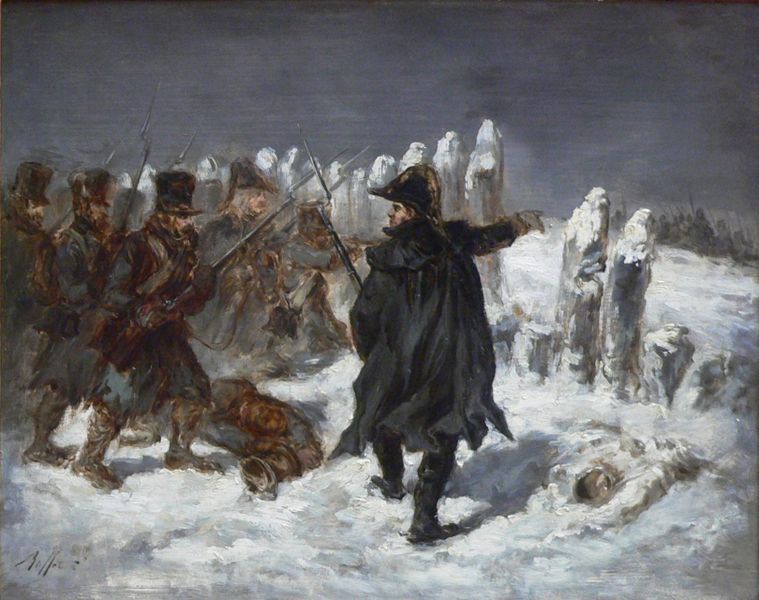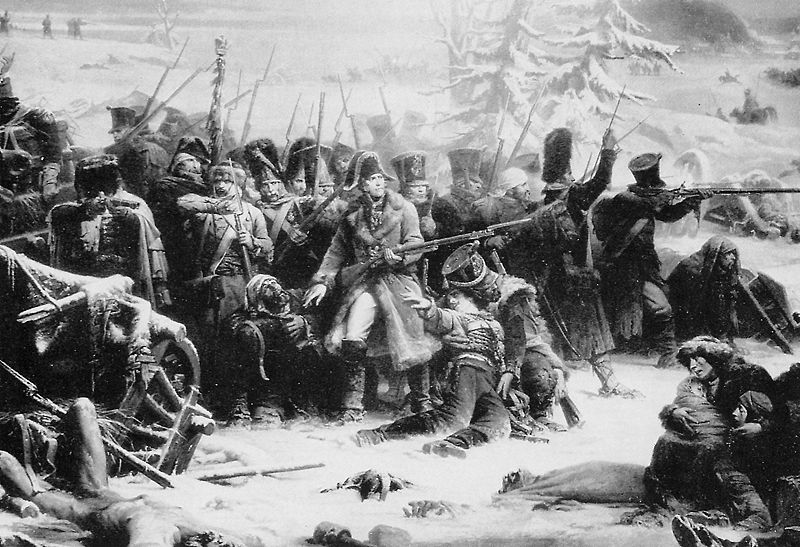<Back to Index>
- Biochemist Sune Karl Bergström, 1916
- Illustrator and Photographer Rudolf Heinrich Zille, 1858
- Marshal of France Michel Ney, 1769
PAGE SPONSOR
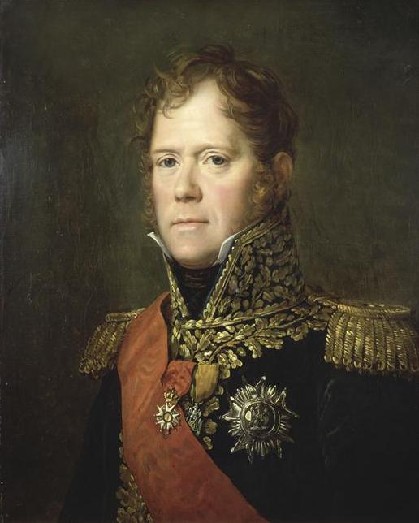
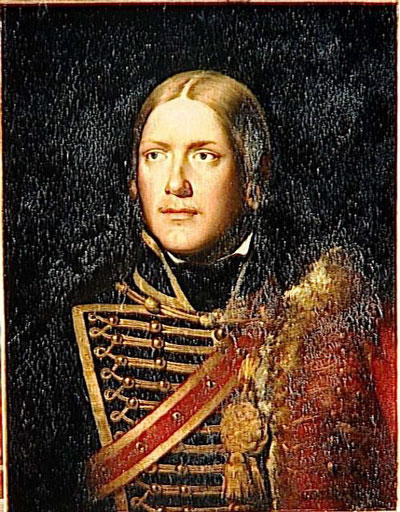
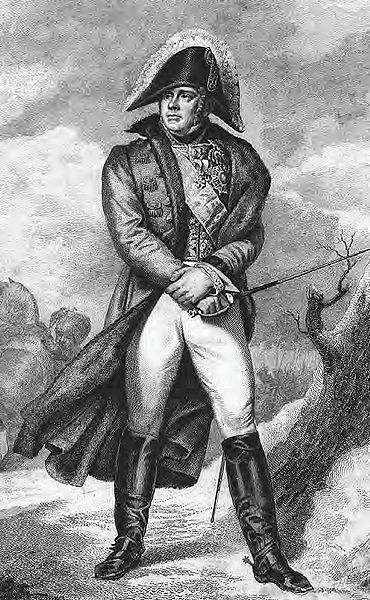
Michel Ney, 1st Duc d'Elchingen, 1st Prince de la Moskowa (10 January 1769 – 7 December 1815) was a French soldier and military commander during the French Revolutionary Wars and the Napoleonic Wars. He was one of the original 18 Marshals of France created by Napoleon I. He was known as Le Rougeaud ("red faced" or "ruddy") by his men and nicknamed le Brave des Braves ("the bravest of the brave") by Napoleon.
Michel Ney was born in Saarlouis, the second son of Pierre Ney (1738 – 1826), a master barrel cooper and veteran of the Seven Years' War, and wife Margarethe Grewelinger (1739 – 1791). Ney was paternal grandson of Matthias Ney (1700 – 1780) and wife Margarethe Becker (d. 1767), and maternal grandson of Valentin Grewelinger and wife Margaretha Ding. His hometown was then a French speaking enclave in a predominantly German speaking portion of Lorraine, and Ney grew up bilingual.
Ney was educated at the Collège des Augustins, and, after his education, became a notary in Saarlouis, and then overseer of mines and forges.
The life as a civil servant did not suit Ney, and he enlisted in the Colonel-General Hussar Regiment in 1787. Ney rapidly rose through the non-commissioned ranks. He served in the Army of the North from 1792 - 94, with which he saw action at the Cannonade of Valmy, the Battle of Neerwinden, and other engagements. Ney was commissioned in October 1792, transferred to the Sambre-et-Meuse in June 1794, and wounded at the Siege of Mainz. Ney was promoted to général de brigade in August 1796, and commanded cavalry on the German Fronts. On 17 April 1797, during the battle of Neuwied, Ney led a cavalry charge against Austrian lancers trying to seize French cannons. The lancers were beaten back, but Ney’s cavalry were counter attacked by heavy cavalry. During the mêlée, Ney was thrown from his horse and made a prisoner of war; on 8 May he was exchanged for an Austrian general. Following the capture of Mannheim, Ney was promoted to géneral de division in March 1799. Later in 1799, Ney commanded cavalry in the armies of Switzerland and the Danube. At Winterthur, Ney was wounded in the thigh and wrist. After Ney’s recovery he fought at Hohenlinden under General Moreau in December 1800. From September 1802, Ney commanded French troops in Switzerland and performed diplomatic duties.
On
19 May 1804, Ney received his Marshal's baton, emblematic of his status
as a Marshal of the Empire, the Napoleonic era's equivalent of Marshal
of France. In the 1805 campaign Ney took command of VI Corps of La Grande Armée, and was praised for his conduct at Elchingen. In November 1805, Ney invaded the Tyrol, capturing Innsbruck from Archduke John. In the 1806 campaign, Ney fought at Jena and then occupied Erfurt. Later in the campaign, Ney successfully besieged Magdeburg. In the 1807 campaign Ney arrived with reinforcements in time to save Napoleon from defeat at Eylau, although the battle ended as a draw. Later in the campaign, Ney fought at Güttstadt, and commanded the right wing at Friedland. On 6 June 1808, Ney was created Duke of Elchingen. In
August 1808 Ney was sent to Spain in command of VI Corps, and won a
number of minor actions. In 1809 he routed an Anglo - Portuguese force
under Sir Robert Wilson at Baños. In 1810 Ney joined Marshal Masséna in the invasion of Portugal, where he took Ciudad Rodrigo from the Spanish and Almeida from the British and Portuguese, brusquely defeated the British on the River Côa, and fought at Buçaco. During the retreat from Torres Vedras, Ney worsted Wellington in a series of much lauded rearguard actions (Pombal, Redinha, Casal Novo, Foz d'Aronce), but was ultimately removed from command for insubordination. Ney was given command of III Corps of La Grande Armée during the 1812 invasion of Russia. At Smolensk, Ney was wounded in the neck, but recovered enough to later fight in the central sector at Borodino.
During the retreat from Moscow, Ney commanded the rear guard and was
anecdotally known as 'the last Frenchman on Russian soil'. After being
cut off from the main army, Ney managed to rejoin it, which delighted
Napoleon. For this action Ney was given the nickname ‘the bravest of the brave’ by Napoleon. Ney fought at Beresina and helped hold the vital bridge at Kovno, where legend has it that Ney was the last man to cross the bridge and exit Russia. On 25 March 1813, Ney was given the title of Prince of the Moskowa. During the 1813 campaign Ney fought at Weissenfels, was wounded at Lützen, and commanded the left wing at Bautzen. Ney later fought at Dennewitz and Leipzig, where he was again wounded. In the 1814 campaign in France, Ney fought various battles and commanded various units. At Fontainebleau Ney
became the spokesman for the Marshals' revolt on 4 April 1814,
demanding Napoleon’s abdication. Ney informed Napoleon that the army
would not march on Paris; Napoleon responded ‘the army will obey me!’ to which Ney answered, ‘the army will obey its chiefs’. When Paris fell and the Bourbons reclaimed the throne, Ney, who had pressured Napoleon to accept his first abdication and exile, was promoted, lauded, and made a peer by the newly enthroned Louis XVIII. Although Ney had pledged his allegiance to the restored monarchy, the Bourbon court reacted coolly to his common origins. When
hearing of Napoleon’s return to France, Ney, determined to keep France
at peace and to show his loyalty to Louis XVIII, organized a force to
stop Napoleon’s march on Paris. Ney also pledged to bring Napoleon back
alive in an iron cage. Napoleon was aware of Ney’s plans and sent him a
letter which said, in part, ‘I shall receive you as after the Battle of
the Moskowa’. Despite Ney’s promise to the King, he joined Napoleon at Auxerre, on 18 March 1815. On
15 June 1815, Napoleon appointed Ney commander of the left wing of the
Army of the North. On 16 June Napoleon's forces split up into two wings
to fight two separate battles simultaneously. Ney attacked Wellington at Quatre Bras (and received criticism for attacking slowly) while Napoleon attacked Blücher's Prussians at Ligny.
Although Ney was criticized for not capturing Quatre Bras early, there
is still debate as to what time Napoleon actually ordered Ney to
capture Quatre Bras. At Ligny, Napoleon ordered General d'Erlon to
move his corps (currently on Napoleon's left and Ney's right) to the
Prussians' rear in order to cut off their line of retreat. D'Erlon
began to move into position, but suddenly stopped and began moving
away, much to the surprise and horror of Napoleon. The reason for the
sudden change in movement is that Ney had ordered d'Erlon to come to
his aid at Quatre Bras. Without d'Erlon's corps blocking the Prussians'
line of retreat, the French victory at Ligny was not complete, and the
Prussians were not routed. To be fair, Ney was d'Erlon's direct superior and Napoleon never informed Ney of his plans. At Waterloo Ney
was again in command of the left wing of the army. At around 3:30 p.m.,
Ney ordered a mass cavalry charge against the Anglo - Dutch line. Ney's
cavalry overran the enemy cannons, but found the infantry formed in
cavalry - proof square formations. Ney, without infantry or artillery
support, was unable to break the squares. The action earned Ney
criticism, and some argue that it led to Napoleon’s defeat at Waterloo. There
is still debate as to the responsibility for the cavalry charge and why
it was unsupported. Ney’s cavalry also failed to spike enemy cannons
(driving an iron spike into the firing hole) while they were under
French control (during a cavalry attack the crew of a cannon retreated
into the squares for protection, and then re-manned their piece as the
horsemen receded). Ney’s cavalry carried equipment needed to spike
cannons, and spiking the cannons would likely have made them useless
for the rest of the battle. The loss of a large number of cannons would
weaken an army and could have caused the Anglo - Dutch force to withdraw
from the battle. Ney
was seen during one of the charges beating his sword against the side
of a British cannon in furious frustration. During the battle he had
five horses killed under him. There has been a theory that the logic of his deciding on some of his actions at Waterloo was affected by post-traumatic stress syndrome caused by his experiences in the Russian campaign. When
Napoleon was defeated, dethroned, and exiled for the second time in the
summer of 1815, Ney was arrested (on 3 August 1815), and tried (4
December 1815) for treason by the Chamber of Peers. On 6 December 1815 he was condemned, and executed by firing squad in Paris near the Luxembourg Garden on
7 December 1815 – an event that deeply divided the French public. He
refused to wear a blindfold and was allowed the right to give the order
to fire, reportedly saying: "Soldiers,
when I give the command to fire, fire straight at my heart. Wait for
the order. It will be my last to you. I protest against my
condemnation. I have fought a hundred battles for France, and not one
against her ... Soldiers, Fire!" Ney's
execution was an example intended for Napoleon's other marshals and
generals, many of whom were eventually exonerated by the Bourbon monarchy. Ney is buried in Paris at Père Lachaise Cemetery. One of the more colorful legends of Ney that grew up after his execution was that he had managed to escape to the United States. Proponents of this theory argue that Ney had Masonic ties, including to the Duke of Wellington,
who helped him fake his execution and flee abroad. According to this
account, the soldiers in the firing squad put blood packets over his
heart and then shot blanks at the Marshal. He was then smuggled to the
United States and continued his life as a school teacher. A man called
Peter Stuart Ney arrived in the United States in 1816, and later taught
school in North and South Carolina, including at Davidson College, where he designed the school seal still in use. He died in 1846, reportedly after uttering the final words, "Bessières is dead; the Old Guard is dead; now, please, let me die." On his gravestone in Cleveland, North Carolina,
at Third Creek Presbyterian Church on Third Creek Church Road, one will
find the words "(...) soldier of the French Revolution under Napoleon
Bonaparte (...)." Another legend has Michael Rudolph, a Continental Army officer in the American Revolutionary War, making his way to France after his forced resignation in 1793 and eventually becoming Ney. Ney married Aglaé Louise Auguié (Paris, 24 March 1782 – Paris, 1 July 1854) at Grignon on
5 August 1802 . Aglaé was the daughter of Pierre César
Auguié (1738 – 1815) and Adélaïde Henriette Genet
(1758 – 1794). Her paternal grandparents were Pierre César
Auguié (1708 – 1776) and Marie Guary (1709 – 1788); her maternal
grandparents were Edmé Jacques Genet (1726 – 1781) and Marie
Anne Louise Cardon. Ney and his wife had four sons.
